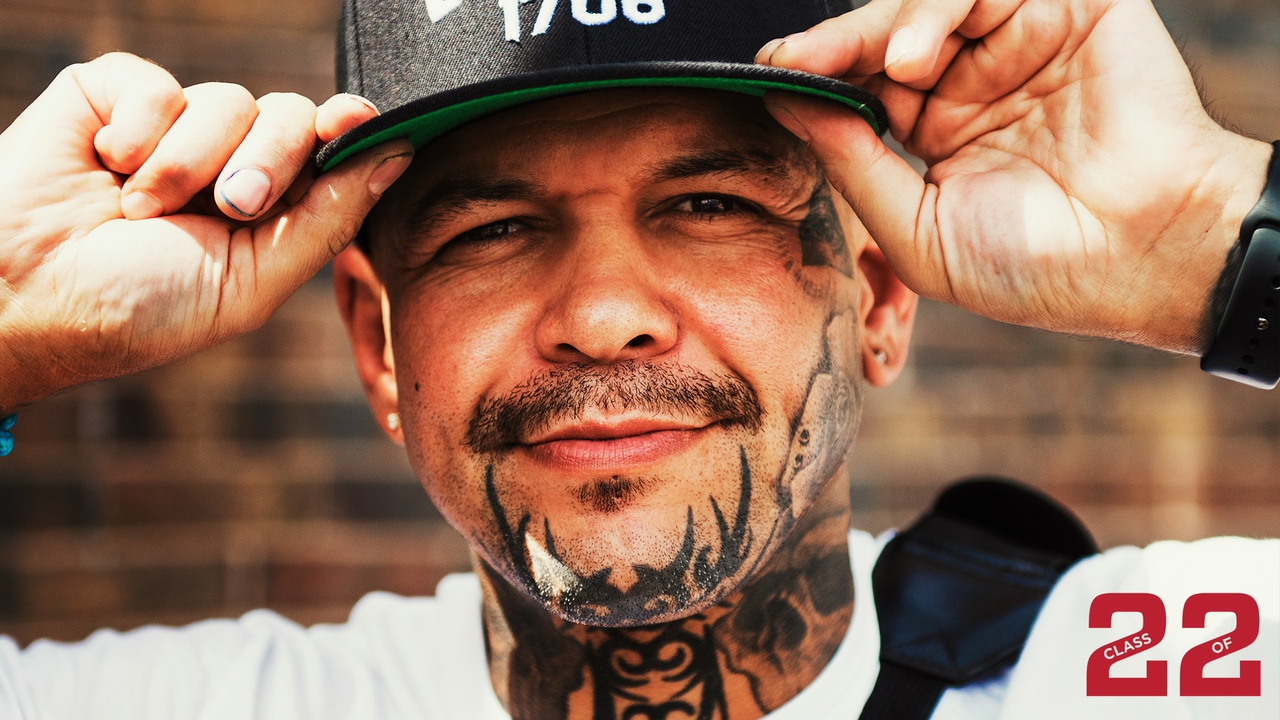Born into a cycle of addiction, University of New Mexico senior Gerald Lovato was a child when he first realized the power of creating art to escape and heal from trauma.
Lovato, who majored in Fine Arts with a studio concentration in Painting and Photography and minored in Arts Business + Leadership, officially graduates this month but walked in the spring ceremony held by El Centro de la Raza.
“It is only offered once per year, and it was important to represent my cultural heritage when graduating. I was awarded the 2022 Raza Excellence Award,” Lovato explained.
An Albuquerque native, Lovato literally struggled through blood, toil, tears, and sweat to achieve his degree. Last year, he lost his nephew to a drive-by shooting and the year before his brother was murdered. In 2002, Lovato himself was a victim of a knife attack in Albuquerque.
“I was stabbed in the face, arm, and leg and nearly bled out. The ulnar nerve in my arm was severed, paralyzing my dominant right hand. My physical therapist recommended I try martial arts to cope with the trauma and build mobility in my hand, which led to a nearly 10-year career in professional mixed martial arts (MMA) competition. When I retired from MMA competition, I began to explore the idea of becoming an artist. Gaining the use of my hand again inspired me to attempt to be an artist… I believe being an older non-traditional student with a large amount of life experience has contributed to my success. I also feel that I bring a lot to the classroom with my perspective.”

Lovato uses his art for not only sharing his own story but also giving the community an opportunity to be heard. His non-traditional Honors exhibition in October reflected his struggles in life and as an artist.
"I was often asked throughout my fight career: Who was your toughest opponent? Upon reflection, the answer was always… myself. I am still fighting myself to find peace and heal from trauma. The Fight for Change performance was a visual representation of healing through art and a representation of my transition from healing through martial arts into visual arts.”
In the gallery, there was a punching bag filled with sand and other materials with a long journal entry densely written on the entire outside of the bag. A large speaker in the gallery played a deep heartbeat throughout the gallery.
“For my performance, I began to hit the bag with my bare hands, breaking the skin. Fresh warm blood dripped from my knuckles on the floor of the gallery and painted the bag red as I hit it as hard as I could. I didn’t know how long this performance was going to be and did not know what was going to happen to me emotionally. This is what is the most exciting for me leading up to the performance. The art told me what it was going to be. During the performance, I walked up to each painting in the loss series and had a conversation with each of the subjects similar to the inner conversations I have with them while making the work. I didn’t plan this part. I completely broke down emotionally and began speaking to the audience, which wasn’t scripted. I don’t remember what was said but it came from the heart.”
The performance came to a dramatic and unexpected end when he hit the bag a final time ̶ unplanned ̶ and it broke from the chains and slammed to the floor.
“I have learned that we hold ourselves back by holding on to trauma. At the end of the performance, with a knife, I cut the punching bag to let out all the sand and filling onto the gallery floor as a visual representation of letting go. The aftermath of the piece became a sculpture for the rest of the exhibition. The blood-stained bag and bloody floor became a reminder of the pain that I had shared with those in attendance."
Lovato’s art focuses on themes that greatly exemplify major problems facing New Mexicans in all demographics.
“After losing so many loved ones in a short period of time while making this body of work, I began to research New Mexico data on suicide, gun violence, and drug addiction, or more specifically the fentanyl epidemic, to find parallels. My research found we rank higher than the national average in New Mexico on all these themes post-pandemic. My research found all these themes to be rooted in behavioral health.”
Lovato credited several professors for helping him through his time at UNM.
“I have had some of the most wonderful professors at UNM. The most powerful connection I had was with my photography professor, Shelby Roberts. She has believed in me since the beginning. My thesis committee was made up of a group of bad-asses, Raychael Stine, Meggan Gould, and Stephanie Woods. They have all had strong impacts on me. Kency Cornejo, my Latinx art history professor helped to expose me to artists who were doing similar work as me in contemporary art.”
Now applying to graduate school for a Master of Fine Arts program, Lovato hopes to continue his education in Fall 2023. As a social practice artist by way of artivism, he eventually plans to launch a nonprofit youth mentorship program for disadvantaged youth in Albuquerque.
“I am applying to some competitive schools including Columbia, UCLA, and Yale so wish me luck! Graduate school will help me develop my art practice in my research around behavioral health which will give me the tools to return to New Mexico and serve my community through the arts… The perfect storm of life events brought me full circle to an amazing education at UNM!”
